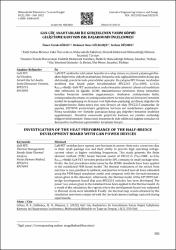Gan Güç Anahtarları İle Gerçeklenen Yarım Köprü Geliştirme Kartının Isıl Başarımının İncelenmesi
Künye
GÖKSU, Ömer Faruk, Mehmet Onur GÜLBAHÇE & Serkan DÜŞMEZ. "Gan Güç Anahtarları İle Gerçeklenen Yarım Köprü Geliştirme Kartının Isıl Başarımının İncelenmesi". Mühendislik Bilimleri ve Tasarım Dergisi, 10.2 (2022): 550-560.Özet
GaN FET anahtarlar ufak paket boyutlarına sahip olması ve yüksek çalışma gerilimakım değerlerini yüksek anahtarlama frekanslarında sağlayabilmesinden dolayı güç
elektroniği çeviricilerinde yeni ufuklar açmıştır. Bu çalışma EPC firması tarafından
üretilmiş olan küçük paket boyutlarındaki EPC2215 (VDS=200V, ID=32A,
RDS(on)=8m) GaN FET anahtarların sonlu elemanlar yöntemi tabanlı ısıl modelinin
elde edilmesini ile ilgilidir. JEDEC standartlarınca belirlenen deney talimatları
kurulan benzetim modeline uygulanmıştır. Anahtarın jonksiyondan kılıfa,
jonksiyondan dış ortama ve jonksiyondan devre kartına olan ısıl dirençleri benzetim
modeli ile hesaplanmış ve firmanın veri föylerinde paylaştığı ısıl direnç değerleri ile
karşılaştırılmıştır. Daha sonra yine aynı firmaya ait olan, EPC2215 anahtarları ile
yapılan, EPC9099 yarım-köprü geliştirme kartının ısıl modellemesi yapılmıştır.
Firma tarafından veri föyünde paylaşılan kayıp güç değerleri benzetim modeline
uygulanmıştır. Benzetim sonucunda geliştirme kartının ısıl yönden zorlandığı
bölgeler belirlenmiştir. Daha sonra benzetim ile elde edilen ısıl dağılım sonuçları ile
deneysel termal kamera görüntüleri karşılaştırılmıştır. GaN FET switches have opened new horizons in power electronics converters due
to their small package size and their ability to provide high operating voltagecurrent values at higher switching frequencies. This study presents the finite
element method (FEM) based thermal model of EPC2215 (VDS=200V, ID=32A,
RDS(on)=8m) GaN FET switches produced by EPC company in small package sizes.
Firstly, the test procedures determined by the JEDEC standards have been applied
to the established FEM-based model. The thermal resistances of the switch from
junction to case, junction to ambient, and junction to board have all been estimated
using the FEM-based simulation model and compared with the thermal resistance
values given in the datasheet. Afterwards, the thermal model of the EPC9099 halfbridge development board that uses EPC2215 switches has been developed. The
power loss values given in the datasheet have been applied to the thermal model. As
a result of the simulation, the regions where the development board was subjected
to thermal stress were identified. Finally, the thermal map results obtained by the
simulation have been compared with the thermal camera readings captured during
experiments.



















